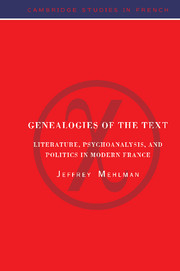Book contents
- Frontmatter
- Contents
- Acknowledgments
- 1 Introduction
- 2 Craniometry and criticism: notes on a Valéryan criss-cross
- 3 Literature and hospitality: Klossowski's Hamann
- 4 Literature and collaboration: Benoist-Méchin's return to Proust
- 5 “Pierre Menard, author of Don Quixote” again
- 6 Iphigenia 38: deconstruction, history, and the case of L'Arrêt de mort
- 7 Writing and deference: the politics of literary adulation
- 8 Perspectives: on Paul de Man and Le Soir
- 9 Prosopopeia revisited
- 10 The paranoid style in French prose: Lacan with Léon Bloy
- 11 The Holocaust comedies of “Emile Ajar”
- 12 Pour Sainte-Beuve: Maurice Blanchot, 10 March 1942
- 13 Flowers of evil: Paul Morand, the Collaboration, and literary history
- Appendix
- Notes
- Index
- Series list
2 - Craniometry and criticism: notes on a Valéryan criss-cross
Published online by Cambridge University Press: 19 January 2010
- Frontmatter
- Contents
- Acknowledgments
- 1 Introduction
- 2 Craniometry and criticism: notes on a Valéryan criss-cross
- 3 Literature and hospitality: Klossowski's Hamann
- 4 Literature and collaboration: Benoist-Méchin's return to Proust
- 5 “Pierre Menard, author of Don Quixote” again
- 6 Iphigenia 38: deconstruction, history, and the case of L'Arrêt de mort
- 7 Writing and deference: the politics of literary adulation
- 8 Perspectives: on Paul de Man and Le Soir
- 9 Prosopopeia revisited
- 10 The paranoid style in French prose: Lacan with Léon Bloy
- 11 The Holocaust comedies of “Emile Ajar”
- 12 Pour Sainte-Beuve: Maurice Blanchot, 10 March 1942
- 13 Flowers of evil: Paul Morand, the Collaboration, and literary history
- Appendix
- Notes
- Index
- Series list
Summary
Un homme d'esprit (lato et stricto sensu) est un homme qui a de bonnes séries. Gagne souvent. On ne sait pas pourquoi. II ne sait pas pourquoi.
Paul Valéry, Mauvaises Pensées et autresFirst series, Poetry. Valéry, during World War I, undertakes, at Gide's suggestion, to consolidate his farewell to poetry by preparing an edition of the vers anciens of his youth, the remains of a vocation he had abandoned during his crisis of 1892 as ultimately deleterious to mind. That farewell, in one of the hoariest episodes of modern literary history, turned into a paradoxical return. Valéry soon found himself embarked in spite of himself on his major poem, “La Jeune Parque,” the “involuntary Aeneid” he completed in 1917. A virgin awakens to find her virginity threatened by the tear she can no longer quite remember having shed during a dream: who indeed could be crying, she asks, beside(s) herself (“Mais qui pleure, / Si proche de moi-même au moment de pleurer?”) (Oeuvres, p. 96). As the tear writes (or “marks”) its way through the Parque's body, provoking its host to flight, it comes to figure the poem itself, the apparently unwanted issue of Valéry's reawakening to poetry. For the subsequent volume Charmes, I have attempted to demonstrate elsewhere, is readable as a transformation of the complex “tear-work” of “La Jeune Parque.”
- Type
- Chapter
- Information
- Genealogies of the TextLiterature, Psychoanalysis, and Politics in Modern France, pp. 11 - 32Publisher: Cambridge University PressPrint publication year: 1995

